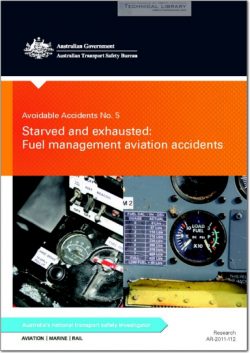ATSB-AR-2011-112
- Version
- 198 Downloads
- 10.36 MB File Size
- 1 File Count
- August 9, 2016 Create Date
- August 9, 2016 Last Updated
Avoidable Accidents No.5 - Starved and Exhausted; Fuel Management Aviation Accidents

Fuel exhaustion happens when an aircraft runs out of usable fuel before the flight
is finished. Exhaustion occurrences are normally either the result of a gross error in
the fuelling of an aircraft before flight, or the result of a number of seemingly minor
aspects of fuel planning and management during the flight.
Incidences of fuel exhaustion often happen close to the flight’s destination and, if
it occurs when the aircraft is close to landing, it may offer the pilot less time and
opportunity to successfully manage the situation.
Certain types of flight regularly carryjust enough fuel for the flight, with little margin.
Flying schools and gliding towing operations may only refuel aircraft after two or three
flights, so the last flight before refuelling can have less fuel margin. Charter operations
may be flying with minimum fuel required because a flight's profitability will depend on
carrying the maximum payload, which means no unnecessary fuel be carried. Such
operations will be more vulnerable to any inaccuracies in the pilot’s knowledge about
the amount of fuel on board. However, fuel exhaustion accidents and incidents occur
in all types of aviation operations. They are normally related to a lack of awareness of
information that is readily available at the pre—flight planning stage. This includes both
the amount of fuel on board, and the rate of fuel consumption.
The chance of fuel exhaustion is reduced if the pilot accurately determines the amount
of fuel on board prior to starting. This should entail the use of a fuel quantity cross-
check using a number of sources, including:
- fuel quantitygauges
- dipsticks
- flowmeters/ totalisers
- calculations from previous refuels and fuel usage, (regularly checked for accuracy).
The amount of fuel on board should be thought of, not as a quantity, but as a flight time.
For a consistent combination of altitude, power setting and mixture setting, the fuel burn
will be constant, but changing winds and deviations due to weather conditions will vary
the groundspeed and therefore the range. Your fuel status should be regularly updated,
at least every hour, to ensure you maintain an adequate reservel.
An aircraft that is carrying onlyjust enough flight fuel2 for the planned flight, but which
encounters unanticipated headwinds and perhaps has to fly at a lower level is eating
into its fuel reserves. Those reserves are there to be used in unforeseen circumstances
and many aircraft arrive safely at their destination having used a portion of the allocated
reserve fuel. However an aircraft’s fuel supply should not reach a state where, upon
arriving at its destination, it can accept no further delay.
| File | Action |
|---|---|
| ATSB-AR-2011-112 Avoidable Accidents No.5 - Starved and Exhausted; Fuel Management Aviation Accidents.pdf | Download |

Comment On This Post